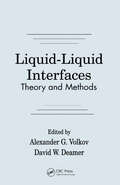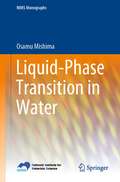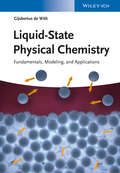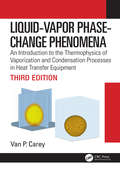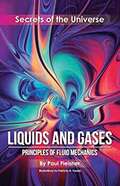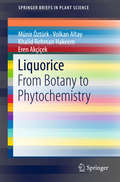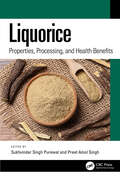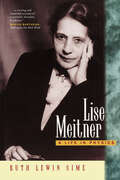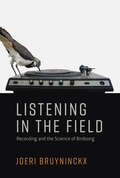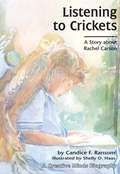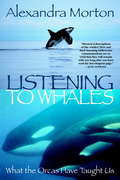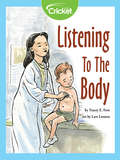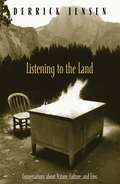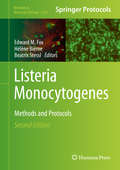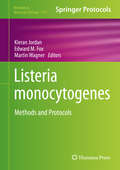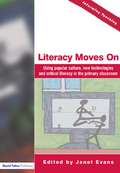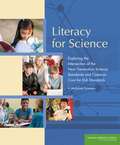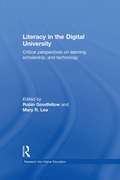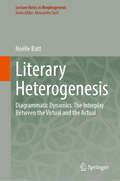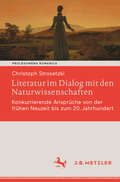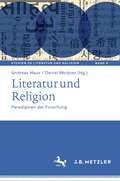- Table View
- List View
Liquid-Liquid InterfacesTheory and Methods
by Alexander G. Volkov David W. DeamerUpdate your knowledge of the chemical, biological, and physical properties of liquid-liquid interfaces with Liquid-Liquid Interfaces: Theory and Methods. This valuable reference presents a broadly based account of current research in liquid-liquid interfaces and is ideal for researchers, teachers, and students. Internationally recognized investigators of electrochemical, biological, and photochemical effects in interfacial phenomena share their own research results and extensively review the results of others working in their area. Because of its unusually wide breadth, this book has something for everyone interested in liquid-liquid interfaces. Topics include interfacial and phase transfer catalysis, electrochemistry and colloidal chemistry, ion and electron transport processes, molecular dynamics, electroanalysis, liquid membranes, emulsions, pharmacology, and artificial photosynthesis. Enlightening discussions explore biotechnological applications, such as drug delivery, separation and purification of nuclear waste, catalysis, mineral extraction processes, and the manufacturing of biosensors and ion-selective electrodes.Liquid-Liquid Interfaces: Theory and Methods is a well-written, informative, one-stop resource that will save you time and energy in your search for the latest information on liquid-liquid interfaces.
Liquid-Phase Transition in Water (NIMS Monographs)
by Osamu MishimaA profound secret of nature hidden in ice water in a glass cup is revealed in this book. The author teaches a simple method for understanding the complex properties of water through the concept of polyamorphism. Polyamorphism is the existence of two kinds of liquid water, leading to a discontinuous transition between them. Currently, this two-water scenario is controversial in the scientific community because definitive experimental proof is difficult. However, a growing number of researchers believe there is adequate circumstantial evidence for the scenario. This introductory book focuses experimental thermodynamic data of liquid water, supercooled water, and amorphous solid water at various pressures and temperatures, and demonstrates how the two-water scenario initially evolved experimentally. The book explains the importance of polyamorphism in comprehending liquid water.
Liquid-State Physical Chemistry
by Gijsbertus De WithFor many processes and applications in science and technology a basic knowledge of liquids and solutions is a must. Gaining a better understanding of the behavior and properties of pure liquids and solutions will help to improve many processes and to advance research in many different areas. This book provides a comprehensive, self-contained and integrated survey of this topic and is a must-have for many chemists, chemical engineers and material scientists, ranging from newcomers in the field to more experienced researchers. The authoroffers a clear, well-structured didactic approach and provides an overview of the most important types of liquids and solutions. Special topics include chemical reactions, surfaces and phase transitions. Suitable both for introductory as well as intermediate level as more advanced parts are clearly marked. Includes also problems and solutions.
Liquid-Vapor Phase-Change Phenomena: An Introduction to the Thermophysics of Vaporization and Condensation Processes in Heat Transfer Equipment, Third Edition
by Van P. CareySince the second edition of Liquid-Vapor Phase-Change Phenomena was written, research has substantially enhanced the understanding of the effects of nanostructured surfaces, effects of microchannel and nanochannel geometries, and effects of extreme wetting on liquid-vapor phase-change processes. To cover advances in these areas, the new third edition includes significant new coverage of microchannels and nanostructures, and numerous other updates. More worked examples and numerous new problems have been added, and a complete solution manual and electronic figures for classroom projection will be available for qualified adopting professors.
Liquids And Gases: Principles Of Fluid Mechanics
by Paul Fleisher Patricia KeelerHave you ever wondered why a 10-tonne boat floats but a tiny pebble sinks? Archimedes knew why. How does a basketball or tennis ball bounce? Robert Boyle could have described how! Can you explain why a hot-air balloon rises but a balloon you blow up drops to the ground? To answer these questions and many more, author Paul Fleisher explains the laws that define how and why liquids and gases behave the way they do. Through simple experiments, detailed illustrations and concepts that are easy to understand, readers are introduced to the basic principles of fluid mechanics in a fun, exciting way. This edition of Paul Fleisher’s Secrets of the Universe has been fully revised by the author and features all of the original illustrations by Patricia Keeler.
Liquorice: From Botany To Phytochemistry (SpringerBriefs in Plant Science)
by Khalid Rehman Hakeem Münir Öztürk Volkan Altay Eren AkçiçekLicorice (Glycyrrhiza) is one of the most widely used in foods, herbal medicine and one of the extensively researched medicinal plants of the world. In traditional medicine licorice roots have been used against treating many ailments including lung diseases, arthritis, kidney diseases, eczema, heart diseases, gastric ulcer, low blood pressure, allergies, liver toxicity, and certain microbial infections. Licorice extract contains sugars, starch, bitters, resins, essential oils, tannins, inorganic salts and low levels of nitrogenous constituents such as proteins, individual amino acids, and nucleic acids. A large number of biologically active compounds have been isolated from Glycyrrhiza species, where triterpene, saponins and flavonoids are the main constitutes which show broad biological activities.The present book will discuss the botany, the commercial interests as well as the recent studies on the phytochemistry and pharmacology of licorice. It will also describe the side effects and toxicity of licorice and its bioactive components, an underrepresented subjects of importance.It will be the first book to present global perspectives of licorice in detail. It will serve as a carefully researched introduction for students, healthcare practitioners, botanists and plant biochemists; full of historical background and bridges the gap between botany, ecology, pharmacology, as well as treatment of diseases.
Liquorice: Properties, Processing, and Health Benefits
by Sukhvinder Singh Purewal and Preet Amol SinghThis book serves as an essential guide for understanding the full potential of this remarkable plant. Drawing from a wealth of scientific research, this book explores every aspect of liquorice, from its nutritional profile to its extensive health benefits. With clear and structured chapters, the book begins with an overview of liquorice nutrient composition, followed by insights into agrarian conditions and the best agricultural practices for cultivating high-quality crops. It explores modern breeding techniques and provides a clear look at how starch is extracted, changed for different purposes, and used in various industries. The exploration continues with secondary metabolites, critical minerals, and how processing affects nutrient retention. A unique highlight is the exploration of liquorice’s untapped potential in health services, showcasing its wide-ranging medicinal properties. Postharvest management strategies ensure quality, while disease control measures and current regulatory guidelines provide a roadmap for safe and efficient production. Whether you are a researcher, a food scientist, or someone curious about the incredible uses of liquorice, this book provides an authoritative resource to unlock its potential.Key Features:• Provides a detailed view of liquorice nutrients and best farming methods.• Explores modern breeding techniques and commercial uses of starch.• Reveals the medicinal properties of liquorice, with detailed applications for health.• Provides guidance on managing crops post-harvest for enhanced quality and safety.• Discusses regulatory frameworks and future possibilities in farming and processing.This book brings together traditional knowledge and modern science which makes it a valuable resource for anyone interested in fully understanding this versatile plant. Whether you're working in research, farming, or food production, this guide gives you the information and tools you need to make smart decisions and drive innovation in the field.
Lise Meitner: A Life in Physics (California Studies in the History of Science #11)
by Ruth Lewin SimeLise Meitner (1878-1968) was a pioneer of nuclear physics and co-discoverer, with Otto Hahn and Fritz Strassmann, of nuclear fission. Braving the sexism of the scientific world, she joined the prestigious Kaiser Wilhelm Institute for Chemistry and became a prominent member of the international physics community. Of Jewish origin, Meitner fled Nazi Germany for Stockholm in 1938 and later moved to Cambridge, England. Her career was shattered when she fled Germany, and her scientific reputation was damaged when Hahn took full credit--and the 1944 Nobel Prize--for the work they had done together on nuclear fission. Ruth Sime's absorbing book is the definitive biography of Lise Meitner, the story of a brilliant woman whose extraordinary life illustrates not only the dramatic scientific progress but also the injustice and destruction that have marked the twentieth century.
List of The Informed Brain in a Digital World
by National Academies Keck Future InitiativeDigital media provide humans with more access to information than ever before-a computer, tablet, or smartphone can all be used to access data online and users frequently have more than one device. However, as humans continue to venture into the digital frontier, it remains to be known whether access to seemingly unlimited information is actually helping us learn and solve complex problems, or ultimately creating more difficulty and confusion for individuals and societies by offering content overload that is not always meaningful. Throughout history, technology has changed the way humans interact with the world. Improvements in tools, language, industrial machines, and now digital information technology have shaped our minds and societies. There has always been access to more information than humans can handle, but the difference now lies in the ubiquity of the Internet and digital technology, and the incredible speed with which anyone with a computer can access and participate in seemingly infinite information exchange. Humans now live in a world where mobile digital technology is everywhere, from the classroom and the doctor's office to public transportation and even the dinner table. This paradigm shift in technology comes with tremendous benefits and risks. Interdisciplinary Research (IDR) Teams at the 2012 National Academies Keck Futures Initiative Conference on The Informed Brain in the Digital World explored common rewards and dangers to Humans among various fields that are being greatly impacted by the Internet and the rapid evolution of digital technology. Keynote speaker Clifford Nass of Stanford University opened the dialogue by offering insight into what we already know about how the "information overload" of the digital world may be affecting our brains. Nass presented the idea of the "media budget," which states that when a new media emerges, it takes time away from other media in a daily time budget. When additional media appear and there is no time left in a person's daily media budget, people begin to "double book" media time. Personal computers, tablets, and smartphones make it easy to use several media simultaneously, and according to Nass, this double-booking of media can result in chronic multitasking, which effects how people store and manage memory. Although current fast-paced work and learning environments often encourage multitasking, research shows that such multitasking is inefficient, decreases productivity, and may hinder cognitive function. National Academies Keck Future Initiative: The Informed Brain in a Digital World summarizes the happenings of this conference.
Listening in the Field: Recording and the Science of Birdsong (Inside Technology)
by Joeri BruyninckxThe transformation of sound recording into a scientific technique in the study of birdsong, as biologists turned wildlife sounds into scientific objects.Scientific observation and representation tend to be seen as exclusively visual affairs. But scientists have often drawn on sensory experiences other than the visual. Since the end of the nineteenth century, biologists have used a variety of techniques to register wildlife sounds. In this book, Joeri Bruyninckx describes the evolution of sound recording into a scientific technique for studying the songs and calls of wild birds and asks, what it means to listen to animal voices as a scientist. The practice of recording birdsong took shape at the intersection of popular entertainment and field ornithology, turning recordings into objects of investigation and popular fascination. Shaped by the technologies and interests of amateur naturalism and music teaching, radio broadcasting and gramophone production, hobby electronics and communication engineering, birdsong recordings traveled back and forth between scientific and popular domains, to appear on gramophone recordings, radio broadcasts, and movie soundtracks.Bruyninckx follows four technologies—the musical score, the electric microphone, the portable magnetic tape recorder, and the sound spectrograph—through a cultural history of field recording and scientific listening. He chronicles a period when verbal descriptions, musical notations, and onomatopoeic syllables represented birdsong and shaped a community of listeners; later electric recordings struggled with notions of fidelity, realism, objectivity, and authenticity; scientists, early citizen scientists, and the recording industry negotiated recording exchange; and trained listeners complemented the visual authority of spectrographic laboratory analyses. This book reveals a scientific process fraught with conversions, between field and laboratory, sound and image, science and its various audiences.
Listening to Crickets: A Story About Rachel Carson
by Candice F. RansomExamines the life of the marine biologist and science writer whose book "Silent Spring" changed the way we look at pesticides.
Listening to Whales: What The Orcas Have Taught Us
by Alexandra MortonAlexandra Morton shares spellbinding stories about her career in whale and dolphin research and what she has learned from and about these magnificent mammals. In the late 1970s, while working at Marineland in California, Alexandra pioneered the recording of orca sounds by dropping a hydrophone into the tank of two killer whales. She recorded the varied language of mating, childbirth, and even grief after the birth of a stillborn calf. At the same time she made the startling observation that the whales were inventing wonderful synchronized movements, a behavior that was soon recognized as a defining characteristic of orca society. In 1984, Alexandra moved to a remote bay in British Columbia to continue her research with wild orcas. Her recordings of the whales have led her to a deeper understanding of the mystery of whale echolocation, the vocal communication that enables the mammals to find their way in the dark sea. A fascinating study of the profound communion between humans and whales, this book will open your eyes anew to the wonders of the natural world.
Listening to Whales: What the Orcas Have Taught Us
by Alexandra MortonIn Listening to Whales, Alexandra Morton shares spellbinding stories about her career in whale and dolphin research and what she has learned from and about these magnificent mammals. In the late 1970s, while working at Marineland in California, Alexandra pioneered the recording of orca sounds by dropping a hydrophone into the tank of two killer whales. She recorded the varied language of mating, childbirth, and even grief after the birth of a stillborn calf. At the same time she made the startling observation that the whales were inventing wonderful synchronized movements, a behavior that was soon recognized as a defining characteristic of orca society. In 1984, Alexandra moved to a remote bay in British Columbia to continue her research with wild orcas. Her recordings of the whales have led her to a deeper understanding of the mystery of whale echolocation, the vocal communication that enables the mammals to find their way in the dark sea. A fascinating study of the profound communion between humans and whales, this book will open your eyes anew to the wonders of the natural world.From the Trade Paperback edition.
Listening to the Body
by Tracey E. FernDoctors have been listening to the sounds of the human body for more than two thousand years, but did not begin associating those noises with health until the mid-1700s. Doctor Rene Laennec remembered the importance of listening when treating his patients, leading him to invent the stethoscope, which doctors still use today.
Listening to the Land: Conversations about Nature, Culture, and Eros
by Derrick JensenDeclaring American culture "the most destructive culture ever to exist," this work presents 29 interviews with a range of activists, theologians, psychologists, and other thinkers who trace a range of themes of related to the relationship between culture and environmental destruction. Among the figures interviewed are Earth First! cofounder Dave Foreman, historian of religion Thomas Berry, technology critic Jerry Mander, Chickasaw poet and novelist Linda Hogan, psychologist Robert Jay Lifton, Native American scholar and activist Ward Churchill, and feminist and peace activists Starhawk. Annotation ©2004 Book News, Inc., Portland, OR (booknews.com)
Listeria Monocytogenes: Methods and Protocols (Methods in Molecular Biology #2220)
by Edward M. Fox Hélène Bierne Beatrix StesslThis updated book explores a wide repertoire of tools and approaches that have been created, modified, and applied to the study of L. monocytogenes, forming the basis of our understanding of the bacterium today. Many of these key experimental techniques are gathered together herein. The volume presents aspects such as clinical disease and host-pathogen interactions, as well as the study of biofilms which present a significant challenge for control of the organism in the food processing environment. The topics covered in this edition also include sampling in order to isolate Listeria, methods for their identification and characterization, methods for gene manipulation, and methods for control of the organism. Written for the highly successful Methods in Molecular Biology series, chapters include introductions to their respective topics, lists of the necessary materials and reagents, step-by-step, readily reproducible laboratory protocols, and tips on troubleshooting and avoiding known pitfalls. Authoritative and up-to-date, Listeria monocytogenes: Methods and Protocols, Second Edition aims to contribute toward the harmonization of methods used to study this important bacterium, and to be of particular interest to Listeria research both in relation to food association and control as well as clinical microbiology.
Listeria monocytogenes
by Kieran Jordan Edward M. Fox Martin WagnerListeria monocytogenes is still a major threat to public health. A new book in the Methods in Molecular Biology series, Listeria monocytogenes: Methods and Protocols addresses its titular pathogen with protocols and methodologies used in research to gain a better understanding of Listeria at a molecular level. The topics covered include sampling in order to isolate Listeria, methods for their identification and characterization, methods for gene manipulation and finally, methods for control of the organism. Written in the highly successful Methods in Molecular Biology series format, chapters include introductions to their respective subjects, lists of the necessary materials and reagents, step-by-step, readily reproducible laboratory protocols and tips on troubleshooting and avoiding known pitfalls. Vital and authoritative, Listeria monocytogenes: Methods and Protocols aims to contribute to the harmonization of the methods used in the field and will therefore benefit all those interested in Listeria research.
Listeria, Listeriosis, and Food Safety (ISSN)
by Elliot T. Ryser Elmer H. MarthSince the second edition of Listeria, Listeriosis, and Food Safetywas published in 1999, the United States has seen a 40 percent decline in the incidence of listeriosis, with the current annual rate of illness rapidly approaching the 2010 target of 2.5 cases per million. Research on this food-borne pathogen, however, has continued unabated,
Literacy Moves On: Using Popular Culture, New Technologies and Critical Literacy in the Primary Classroom
by Janet EvansThis book looks at the changing nature of literacy and at the way in which new and different literacies are emerging in the first part of the 21st century. It considers how children are shaping and being shaped by these changes, it also looks at how teachers need to bridge-the-gap between children's out of school interests and school based curriculum demands. This edited collection, which features chapters by international experts and voices in the field, aims to: Take a closer look at (and demystify) some of the influences on literacy in the 21st century e.g. popular culture, multi-modal texts, email, text messaging and critical literacy. Enhance teachers' awareness of these developments and show how they can use them to improve the literacy skills of their pupils. Show, through the Implications for Practice sections, how teachers can find different but straightforward ways of linking children's personal, out-of-school interests with the demands of the school curriculum.
Literacy for Science: A Workshop Summary
by Holly RhodesThe recent movement in K-12 education toward common standards in key subjects represents an unprecedented opportunity for improving learning outcomes for all students. These standards initiatives - the Common Core State Standards for English Language Arts and Mathematics (CCSS) and the Next Generation Science Standards (NGSS) - are informed by research on learning and teaching and a decade of standards-based education reform. While the standards have been developed separately in English/Language Arts and Science, there are areas where the standards intersect directly. One such area of intersection occurs between the "Literacy in Science" portions of the Common Core State Standards for English/Language Arts and the practices in the NGSS (originally outlined in the NRC's A Framework for K-12 Science Education), particularly the practice of "Obtaining, evaluating and communicating information. " Because the CCSS literacy in science standards predated the NGSS, developers of the NGSS worked directly with the CCSS team to identify the connections between the two sets of standards. However, questions about how the two sets of standards can complement each other and can be used in concert to improve students' reading and writing, as well as listening and speaking, in science to learn science continue to exist. "Literacy for Science" is the summary of a workshop convened by the National Research Council Board on Science Education in December 2013 to address the need to coordinate the literacy for science aspect of CCSS and the practices in NGSS. The workshop featured presentations about the complementary roles of English/language arts teachers and science teachers as well as the unique challenges and approaches for different grade levels. "Literacy for Science" articulates the knowledge and skills teachers need to support students in developing competence in reading and communicating in science. This report considers design options for curricula and courses that provide aligned support for students to develop competencies in reading and communicating, and addresses the role of district and school administrators in guiding implementation of science and ELA to help ensure alignment. "Literacy for Science" will be a useful point of reference for anyone interested in the opportunities and challenges of overlapping science and literacy standards to improve the learning experience.
Literacy in the Digital University: Critical perspectives on learning, scholarship and technology (Research into Higher Education)
by Robin Goodfellow Mary R. LeaLiteracy in the Digital University is an innovative volume bringing together perspectives from two fields of enquiry and practice: ‘literacies and learning’ and ‘learning technologies’. With their own histories and trajectories, these fields have seldom overlapped either in practice, theory, or research. In tackling this divide head on, the volume breaks new ground. It illustrates how complementary and contrasting approaches to literacy and technology can be brought together in productive ways and considers the implications of this for practitioners working across a wide range of contexts. The book showcases work from well-respected authorities in the two fields in order to provide the foundations for new conversations about learning and practice in the digital university. It will be of particular relevance to university teachers and researchers, educational developers and learning technologists, library staff, university managers and policy makers, and, not least, learners themselves, particularly those studying at post-graduate level.
Literary Heterogenesis: Diagrammatic Dynamics. The Interplay Between the Virtual and the Actual (Lecture Notes in Morphogenesis)
by Noëlle BattThis book advances a new interdisciplinary approach that engages with the concepts of science and literature through the mediation of philosophy (with a focus on the ideas of Gilbert Simondon and Gilles Deleuze). It investigates in innovative ways the multifaceted dimensions of creation, of genesis, considered here in artistic and mathematical terms as “heterogenesis”. The dialogic interaction among the three domains generates a renewed analysis of poems selected in the work of particularly inventive poets, both French and American—Emily Dickinson, e.e. cummings and Francis Ponge—as well as the artwork of Pierre Soulages, Anna-Eva Bergman and Cy Twombly. Literary Heterogenesis. Diagrammatic Dynamics. The Interplay of the Virtual and the Actual will interest specialists of mathematics, physics, literary theory and criticism, philosophy, and epistemology. It will also attract any curious mind drawn to the bridging of disciplines and the concepts of the two cultures.
Literatur im Dialog mit den Naturwissenschaften: Konkurrierende Ansprüche von der frühen Neuzeit bis zum 20. Jahrhundert (Prolegomena Romanica. Beiträge zu den romanischen Kulturen und Literaturen)
by Christoph StrosetzkiDie These des Buches ist, dass in der frühen Neuzeit die Literatur den Vorrang vor der Naturbetrachtung beanspruchte. Verschiebungen gab es über Phasen zeitweiliger Parität, der Priorität der Naturwissenschaften im 19. Jahrhundert bis zu deren Kritik im 20. Jahrhundert von Seiten der Literatur. Dargestellt werden diese Entwicklungen in Frankreich und im spanischsprachigen Raum, wobei auch Deutschland und England Berücksichtigung finden: Während Montaigne, Pedro Mexía, Pérez de Oliva, Vives und Gracián der Literatur die Priorität geben, stellt Pascal dem „esprit de finesse“ den „esprit de géométrie“ gegenüber und eröffnet eine Kontroverse, die Linné und Buffon fortsetzen. Aufklärer wie Voltaire orientieren sich am englischen Modell. Hier führen Locke und Hume Erfahrungswissenschaften ein, deren Fortschritte Rousseau kritisiert. Setzen sich im 19. Jahrhundert Balzac und Pérez Galdós mit den Naturwissenschaften auseinander, werden dann bei Zola Darwin und Comte zu Vorbildern. Die Aporien des naturwissenschaftlichen Denkens schließlich zeigen Ortega y Gasset, Borges und Sábato auf.
Literatur und Religion: Paradigmen der Forschung (Studien zu Literatur und Religion / Studies on Literature and Religion #6)
by Daniel Weidner Andreas MauzIn den letzten Jahren hat sich die Forschung zu den Beziehungen von Literatur und Religion unverkennbar intensiviert. Der vorliegende Band unterzieht sie einer Bestandsaufnahme und fragt nach den Paradigmen, die diese Arbeiten geleitet haben und leiten. Welche Fragen stellt die Forschung – welche nicht (mehr)? Welche theoretischen und methodischen Orientierungen bestimmen den Diskurs? Wie könnte er sich in Zukunft entwickeln? Lassen sich disziplinäre oder auch interdisziplinäre Paradigmenwechsel ausmachen? Die Beiträge rekonstruieren die Forschungsgeschichte etwa zum Trauerspiel, zu Klopstock oder zum antiken Roman und geben Überblicke über breitere Diskurse wie die literaturwissenschaftlich orientierten Bibelwissenschaften, die religionsbezogene Comic-Forschung oder die US-amerikanische Debatte über „Literature and Religion“.
Literature After Darwin
by Virginia RichterWhat makes us human? Where is the limit between human and animal? These are questions that haunt post-Darwinian literature. Covering fiction from Kipling to Kafka, this study offers a historically embedded analysis of anthropological anxiety in the period between the publication of the Origin of Species and the beginning of the Second World War.
